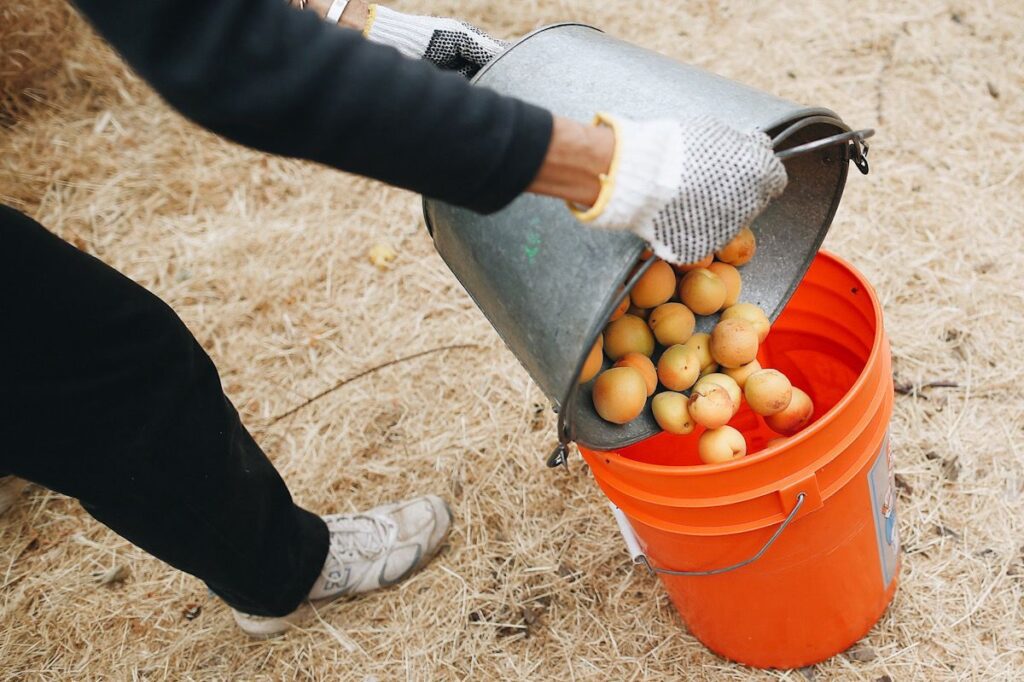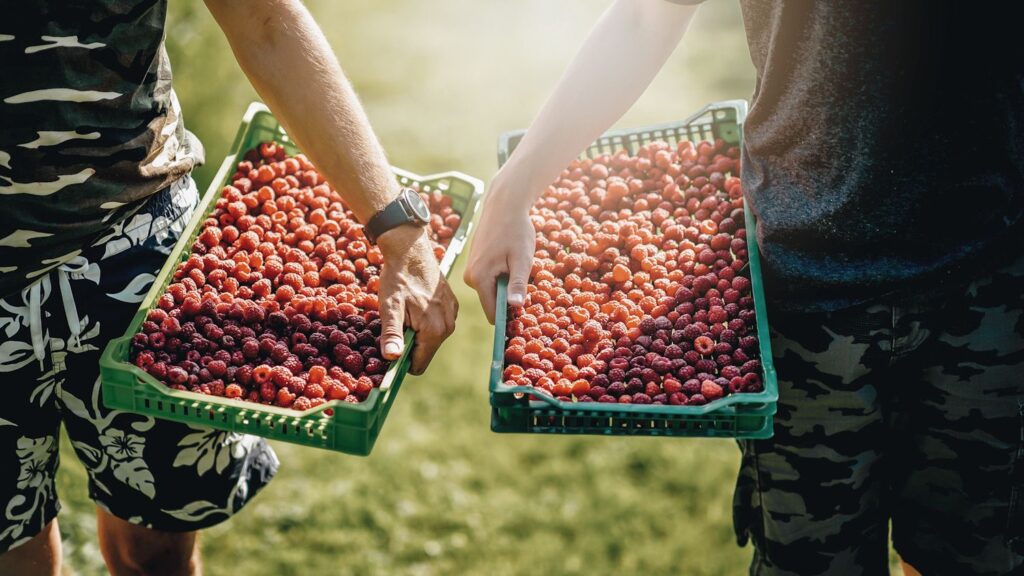Even in the 21st century, there’s an ancient agricultural practice detailed in both the Old Testament and the Koran that could hold the keys to feeding hungry people and saving the planet at the same time.
Gleaning, the simple process of gathering surplus produce from farm fields and even residential backyards, puts food on plates and keeps it out of landfills. It seems like the perfect solution to food shortages, and the people who run gleaning programs across the United States are universally agreed on one point: We have plenty of food in this country to feed everybody, if only we can stop wasting it.
“There will always be excess in the fields,” says Shawn Peterson, director of the Association of Gleaning Organizations. “We could do a far better job of managing it.”
How gleaning can help address food insecurity
In 2021, the U.S. Food and Drug Administration identified that over 38 million Americans were food insecure, meaning they did not have an adequate amount of food on a daily basis to meet their basic nutritional needs. At the same time, 21 percent of food ends up in landfills, where that rotting food generates harmful methane gases that accelerate climate change. And as the Covid-19 pandemic fed unemployment in 2020, some 60 million Americans turned to food assistance programs for help, twice as many as in the previous year, but inequitable distribution meant that many communities—particularly in rural areas and among communities of color—still went without.
“There are plenty of fruits and vegetables to go around,” says Nkemdilim Nwosu, director of communications at Food Forward, a Southern California nonprofit that addresses food insecurity and food waste in multiple ways, including gleaning surplus fruit, such as citrus and avocados, from private properties, public parks, and orchards. “The issue is about providing equal access to healthy foods.”
Gleaning allows organizations like Food Forward to address hunger by focusing on sustainability, building connections between farmers, distributors, and local communities, and directly impacting hungry people in senior centers, veterans’ homes, day care facilities, assisted living, and homeless shelters.

Those connections are invaluable, notes Lisa Ousley, executive director of After The Harvest in Kansas City, Missouri. The nonprofit had already been operating since 2014 when the pandemic hit, primarily focused on working with large commercial growers around the country to get donations of truckloads of already-harvested B-grade fruits and vegetables—millions of pounds of completely edible produce that doesn’t meet USDA standards, such as cucumbers that are more than seven inches long, misshapen bell peppers, or limes that are the wrong shade of green. Gleaning was a much smaller part of their efforts, but it all added up to keeping perfectly good food out of the waste stream and into the hands of those who needed it most.
But with the onset of Covid-19, Ousley saw a surprising problem as a result of the USDA’s Farmers To Families Food Box program, which was created in the spring of 2020 to address disruptions to the food supply chain by purchasing fresh food directly from producers and delivering it to food banks. “Kansas City was suddenly flooded with free produce,” Ousley says, “but it wasn’t being distributed equitably. That food box program ended up driving our gleaning expansion so that we could focus on our local community and get food to those who desperately needed it.”
There are plenty of fruits and vegetables to go around. The issue providing equal access to healthy foods.
Nkemdilim Nwosu, director of communications at Food Forward
Gleaning programs like the one at After The Harvest tend to be volunteer-heavy. People in the community, from retirees to college students, head out to the fields when a farmer has excess produce that needs to be harvested, such as a crop of zucchini that has been pock-marked by a hail storm and can’t be sold at market; in a few hours, those volunteers harvest hundreds of pounds of produce for distribution to food banks and other local agencies. One specialized group of volunteers at After The Harvest is known as the VEG (Vegetable Emergency Gleaning) Squad, responds to farmers on short notice when, for instance, a forecast for a sudden hard frost threatens a tomato crop. The recent acquisition of a refrigerated truck has made it easier for Ousley’s gleaners to get even more produce out into the local community while it’s still fresh—another important step in keeping gleaned fruits and vegetables out of landfills.
In Montgomery County, Maryland, just outside Washington, DC, gleaning is one of many strategies being implemented toward “zero waste” goals, including at Community Food Rescue, where they now have six to eight gleans at local farms each year. Program director Cheryl Kollin says, “Food rescue is not the solution to establishing food security or rectifying the waste stream issue, but it is a great solution to the reality that a farmer’s life is hard. They have to hedge their bets against weather conditions, crop failure, and labor shortages—and, in a good year, they might have more than they can sell.”
If that leftover produce isn’t gleaned, then many farmers simply till it over to fertilize the field for the next planting season. However, there can also be crops, often overlooked, that are valuable to immigrant and indigenous communities and worth gathering, says Kollin. One such crop was recently identified by the nonprofit Red Wiggler Community Farm, which called Kollin to ask for gleaning volunteers to harvest the leaves from sweet potatoes—a prized ingredient in recipes across Asia, Africa, and the South Pacific.
“It’s a very labor-intensive process,” say Kollin, “because you have to separate the leaves from the stems, but harvesting them means that we are providing an ingredient that members of the local community value while keeping that crop out of the landfill at the same time.”

Hunger is not a production problem, it’s a distribution problem.
Shawn Peterson, director of the Association of Gleaning Organizations
Gleaning is typically referred to as very reactive, because it is often necessitated by a sudden need to gather produce before it rots. However, more organizations are understanding that being intentional can benefit the populations they serve and reduce food waste at the same time, meaning that some gleaners are getting into farming the land themselves. Boston Area Gleaners, which distributed over eight million pounds of food in 2020 alone, is one such group: they recently purchased farmland in Acton, Massachusetts, allowing them to be more proactive in the planning of their food distribution and how they impact the waste stream.
Paul Franceschi, outreach coordinator for Boston Area Gleaners, is excited about how this venture allows them to provide greater food options beyond typical regional staples to their community. “We have feedback from our partners already in some of the crops they’d like to see more of,” says Franceschi, “including a bigger variety of cultural crops that aren’t always available in the emergency food system. We’re getting set to plant okra and collards in the fields soon, among other crops.”
In an ideal world, everyone would have access to nutritious food and far less of it would be wasted. Gleaning advocates know these are big, complex issues to solve.
The Association of Gleaning Organizations noted in its 2020 annual report that it is estimated by the World Wildlife Fund that 10 billion pounds of produce grown globally is never harvested, while one in seven people is experiencing food insecurity at the same time. That wasted food represents 10 percent of greenhouse gas emissions, almost quadruple that created by the airline industry.
“Hunger is not a production problem,” says director Peterson, “it’s a distribution problem. We have far too much food and a pressing issue of climate change. Gleaning offers a way to empower local communities to use that excess and have a real impact on people and the environment.”
The views expressed in opinion pieces are those of the author(s) and do not represent the policy or position of LIVEKINDLY.


